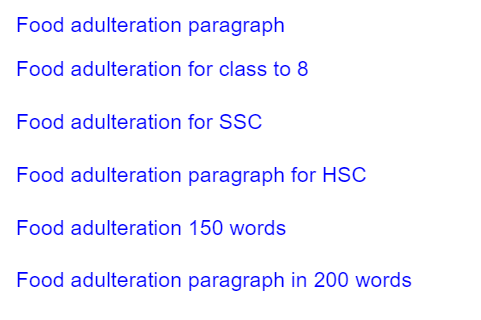Food adulteration paragraph
Food adulteration intentionally adds toxic substances to food. It can put human lives at risk, affecting food items we regularly eat. People face dangers daily from eating food contaminated with metals and chemicals. This directly results from anthropogenic activities like car pollution and industrial waste dumped into the soil. They can be mixed with harmful chemicals, with chemical colors, and replaced with substandard products. Some of the most commonly adulterated foods are milk, spices, oils, and sweets. Eating contaminated food can cause serious diseases, disorders, and long-term illnesses such as cancer. When purchasing food products, consumers should be cautioned and strict regulation is required.
Food adulteration is not only harmful to health but also hurts a lot of regards to food producers.
Food adulteration paragraph in 200 words
When ingredients are added or removed to make food harmful, it’s called food adulteration. While this practice is illegal, it is often motivated by profit maximization. People often find that their food, such as milk, oils, spices, and sweets, could be more pure. Cheap substitutes or chemicals are added to make these foods look better and last longer. This means they are eating things that aren’t what they seem, which can be harmful. These contaminants may be highly toxic, resulting in food poisoning and gastrointestinal complications, or, more tragic scenarios, permanent health diseases such as renal dysfunctions and cancers.
A few common types of food adulteration are mixing water in milk, adding powdered stones to spices, and using artificial sweeteners to make sweets. Not only does this decrease the food’s Nutritional value, but it also increases the chances of toxic exposure. The government must enforce regulations on food storage, cultivation facilities, etc. Open-field food safety inspections are a must, and they are very visible. Consumers should also know how to identify contaminated food and go for properly certified, quality products.
In conclusion, A stringent regulatory framework and consumer consciousness are needed to guarantee that the food is safe for everyone.
Food adulteration paragraph for HSC
Food Adulteration is an intentional act to impair the quality and safety of food by adding inferior, toxic or low-quality material. Mixing artificial colors, chemicals, and even edible items to make food is the most common contaminated food, including milk, oils, spices, sweets, etc. The impurity in these reduces the nutritional content of food items. However, consuming such food items in the long term may lead to serious health crises like ascites, gastrointestinal and organ damage and, in the worst case, cancers.
These products, mixed with harmful substances, are being sold in the open market, and tolerant consumers are at risk. However, with stronger laws, regular food inspections, and an alert consumer base, we can collectively identify and avoid such dubious food items, which is crucial in securing food safety.
In conclusion, food adulteration is one of the major risk factors for public health and erodes trust in the food supply.
Food adulteration 150 words
Food adulteration is the deliberate process of adding impurities to food. It can also refer to removing some constituents from the original food, making it unsuitable for consumption. Judicious human cognition and common sense possess the reins of growth; the well-cultivated corporate space must take lessons from this greed-induced unethical move underlying profit maximization. These things are often adulterated next to milk, oils, spices, and sweets, mixed with chemicals, artificial colours, or cheaper alternatives. These adulterants, on the one side, decrease the nutrient value in food and are responsible for life-endangering diseases like food poisoning.
Unaware consumers are the unfortunate victims, purchasing these harmful products during their shopping and exposing themselves to serious health risks. Policymakers must act swiftly to create and enforce more stringent food security policies and conduct regular inspections to protect the public.
Consumers are awakening to the need to refrain from eating adulterated food, and strict legal action is required to enforce this law.
Food adulteration for SSC
Food adulteration adds harmful and lower-quality ingredients to foodstuffs that could be dangerous for consumption. This is done to save production costs and increase profitability. Adulterated food items include milk, spices, oils, and sweets. These products often contain adulterants in chemicals, artificial colors, and low-price plain substitutes that can cause serious health risks. The victim suffers from food poisoning and digestive troubles, as well as the possibility of carcinoma diseases.
The ignorance of people who consume such a large number is a major issue, considering all the harmful effects of food adulteration. To solve this problem, the government should standardize the food safety standards and conduct regular inspections of these products to ensure their safety. This proactive role of the government should reassure consumers that steps are being taken to protect their health.
Food adulteration is a harmful practice that threatens people.
Food adulteration for classes 6 to 8
Things that are usually adulterated include milk, spices, oils and sweets. Other times, these foods with chemicals, artificial colors or inexpensive ingredients are mixed for a better presentation and durability. Although consuming fake food may be a little taste, it can cause stomach pain, food poisoning and, in the worst case, was born with more serious diseases after many years. Another major problem is food adulteration, which some people may need to be made aware of when they consume mixed with something. The government should inspect food at intervals and ensure safe food is not sold.
Food adulteration is a consequential threat to health. Our collective responsibility is to ensure we only buy food items that meet safety standards. Being watchful and informed consumers can play a crucial role in combating this issue.
To learn more about The Padma Bridge paragraph and Tree plantation Paragraph.

